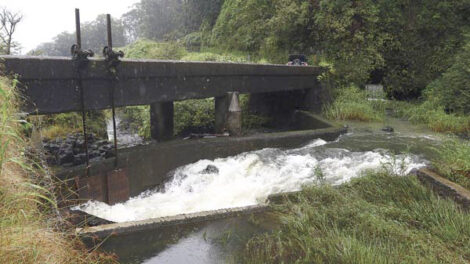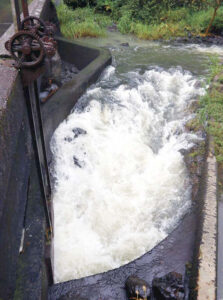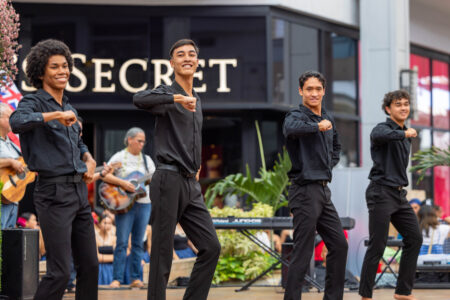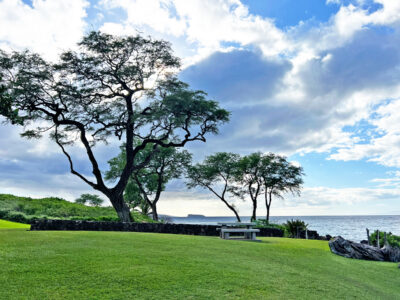Court cuts East Maui water diversions again
A&B, EMI will take 9 mgd less than what state had permitted
The state’s Environmental Court has lowered the amount of water that Alexander & Baldwin and East Maui Irrigation can take from East Maui streams by about 9 million gallons per day, the latest decision in a longstanding battle over diverted water for farming and other uses.
Under the ruling, A&B and EMI’s allocation drops from nearly 40.5 mgd to 31.5 mgd, a decision that Sierra Club Director Wayne Tanaka called a “victory for the streams, and a vindication of both the law and the facts.”
“Water is life. It is our most precious resource. And this ruling will help us to strike a better balance in the sharing and protection of east Maui’s streams, at least for the near future,” Tanaka said in a statement on Monday afternoon.
EMI is jointly owned by A&B and Mahi Pono, which purchased about 41,000 acres of former sugar cane land from A&B in 2018 and is currently growing citrus, coffee, onions and other crops. The court ruling allows Mahi Pono to still take the same amount of water that it’s allocated under a state permit.
“Mahi Pono is currently reviewing Judge Crabtree’s decision,” the farming company said in a statement on Monday afternoon. “As our team assesses the ruling, we remain committed to increasing food security for our state and reducing our island’s reliance on imported crops.”
An A&B spokesperson said Monday evening, “We are reviewing the court’s decision and its impact on the future of the renewal of agriculture in Central Maui and the provision of water to the people in Upcountry Maui.”
At the heart of the latest dispute are the one-year, revocable permits that the state has issued to A&B for two decades, allowing the company to divert water from East Maui streams. While a court decision in 2016 found the practice violated state law, another court overturned the ruling in 2019 and opened the door for the permits to be issued again.
Since then, the Board of Land and Natural Resources has continued to issue the revocable permits each year, and the Sierra Club has repeatedly challenged the decisions in court, prompting a tug-of-war over how much water should be taken from the streams.
When the board issued the revocable permits for 2021, it set a cap of 45 mgd on stream diversions, Judge Jeffrey Crabtree wrote in a decision filed Friday afternoon in First Circuit Court. BLNR refused Sierra Club’s request for a contested case hearing at the time. The court said this violated the Sierra Club’s constitutional rights and cut the water allocation to 25 mgd in July 2021, and later to 20 mgd in April 2022 until the board could hold the hearing and issue new permits.
On June 30, 2022, after conducting the hearing, BLNR issued new permits, raising the cap back up to 45 mgd for the rest of the calendar year. Sierra Club filed a challenge, but the court found the issue was “moot” because the 2022 permits expired by the time a decision came around.
In November 2022, BLNR approved permits that would allow up to 40.49 mgd to be diverted, while denying Sierra Club a contested case hearing, board minutes show.
Crabtree said that the permits “cannot stand” under Supreme Court precedent and that BLNR must hold a contested case hearing upon request if it considers issuing new revocable permits for 2023.
“Sierra Club does not have all the answers. Neither does BLNR or Alexander & Baldwin. (And neither does this court.),” Crabtree wrote. “But it offends the constitution when BLNR dismisses Sierra Club’s advocacy out of hand by denying them a meaningful opportunity to be heard — even if with good or neutral intentions (saving BLNR time and resources).”
The judge pointed out that from July 30, 2021, when the court first cut the allocation to 25 mgd, to June 30, 2022, when the board issued new permits, “Defendants did not come back to court during those eleven months to ask the court to increase the court-imposed MGD cap.”
“The court draws an inference from this sequence that despite the lowered cap on MGD, Defendants got enough water from the streams to meet their actual needs,” Crabtree said. “This does not necessarily mean the lower MGD cap actually saved water. The court simply infers that the court’s imposed caps of 25 MGD and then 20 MGD were apparently high enough to sustain Defendants’ needs from July 30, 2021 to June 30, 2022 — a period of 11 months. Otherwise, the court concludes it is likely Defendants would have come back to court and asked for more water if they truly needed it.”
According to the ruling, the 40.49 mgd allowed under the latest BLNR permits includes 27.91 mgd for Mahi Pono; 6 mgd for the Maui County Department of Water Supply; 1.5 mgd for the county’s Kula Ag Park; 0.07 mgd for historic/industrial uses; 2.2 mgd for other uses such as reservoirs, dust and fire; and a cushion of 2.79 mgd.
However, only 25.27 mgd is being used, including 18 mgd for Mahi Pono; 6 mgd for the Department of Water Supply; 1.5 mgd for the Kula Ag Park; 0.12 mgd for historic/industrial uses; and 3.65 mgd for other uses. The net total takes into account 4 mgd of available groundwater that help offset the daily uses.
Under the court’s ruling, about 31.5 mgd will be allowed, including 27.91 mgd for Mahi Pono; 6 mgd for the Department of Water Supply; 1.5 mgd for the Kula Ag Park; and 0.07 mgd for historic/industrial uses. This also takes into account 4 mgd of available groundwater. Crabtree removed the allocations for other uses, saying it would come from the county’s water, and also removed the cushion, saying the 27.91 mgd for Mahi Pono already factors in uncertainty like new plantings and maturing crops.
“The court has ruled against Sierra Club in some of these cases and has ruled for BLNR and Alexander and Baldwin in some of these cases. These issues are hard,” Crabtree said. “All the parties are motivated to one degree or another to protect our natural resources. But they disagree on how much protection and at what cost.”
“The court respectfully requests the parties pause, put down their swords, take a look around, and decide to engage with each other in good faith to protect our natural resources — while also leaving room for sustainable uses of those natural resources for legitimate purposes in the public interest,” he added.
* Managing Editor Colleen Uechi can be reached at cuechi@mauinews.com.
- Kopiliula Stream flows through a ditch beneath Hana Highway in 2017. A recent ruling in Environmental Court has reduced the amount of water that can be diverted from East Maui streams. The Maui News file photos
- Water flows from the Kopiliula Stream through the Koolau Ditch beneath Hana Highway in 2017.





